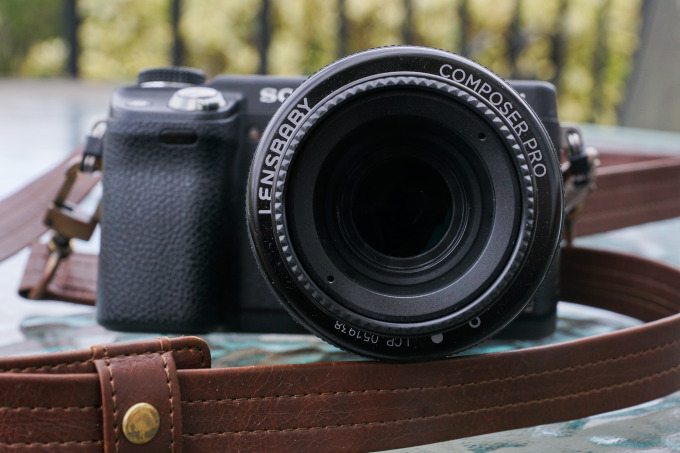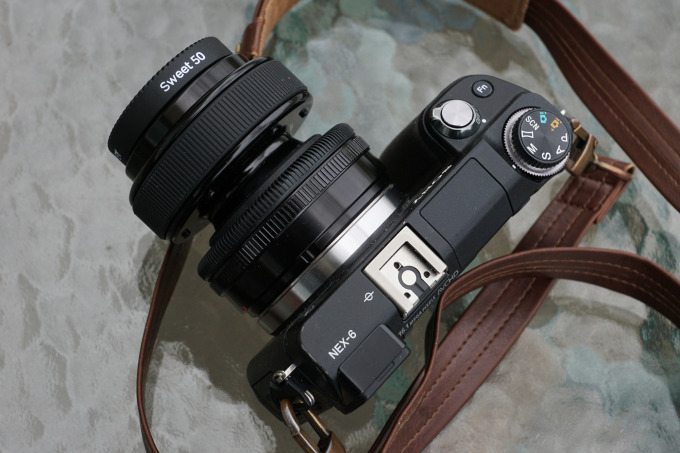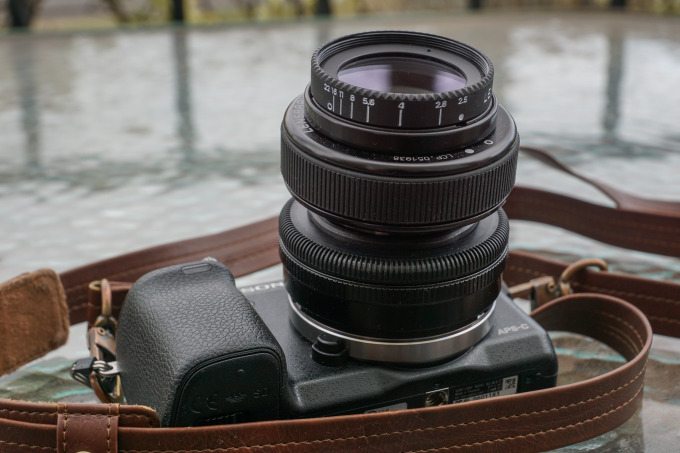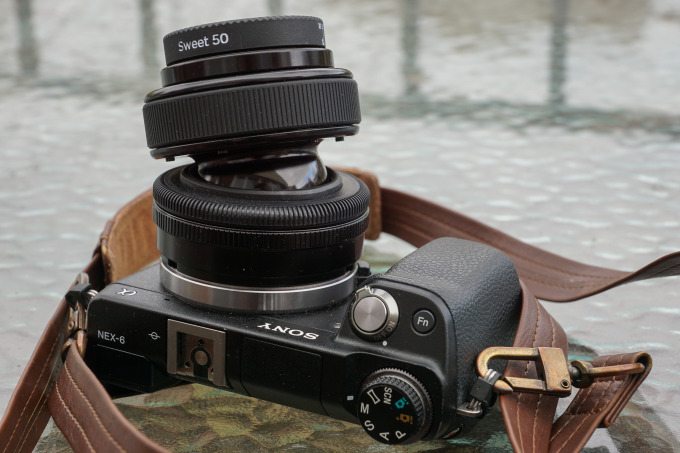Last Updated on 12/16/2014 by Julius Motal

So it was that I received a Lensbaby Composer Pro with Sweet 50 Optic and an NEX-6 for review. It had been a while since I last handled one of Lensbaby’s creations, the Scout and Muse specifically, and this one was considerably different. It looks like a cannon had been miniaturized to fit on the NEX-6, or something that might have been affixed to the robot from Lost in Space. The Composer Pro was a quirky break from the usual spate of reviews, but it isn’t for everyone.
Pros and Cons
Pros
-Smooth bokeh around the focal point is nice to look at
-The aperture ring is a welcome upgrade from the aperture disks of yore
-Fairly affordable at $299
Cons
-The front element can often be difficult to adjust on the fly
-There’s a bit of a steep learning curve
-Aperture values are on the bottom of the lens barrel, which doesn’t make any sense
Gear Used
For this review, we used the Lensbaby Composer Pro with Sweet 50 Optic on a Sony NEX-6.
Tech Specs
Courtesy of B&H Photo Video’s listing:
- Sony E Mount
- 50mm Selective Focus Optic
- Aperture Range: f/2.5 to 22
- Curved Field of Focus
- Manual Focus
- 2 Multi-Coated Glass Elements
- Smooth Ball & Socket Selective Focus
- 12-Blade Internal Aperture
- 46mm Front Threads
Ergonomics

Here is the Composer Pro in all its quirky construction. The front element moves on a ball-and-socket joint, and wherever you position is where the focal point will be. When you set it down for the day, center the focus point, so that you don’t forget if you pick it up in a hurry on your way out the door.

The very front of the lens is where you adjust your aperture. The Composer Pro has an aperture range of f2.5-22. Lensbaby units of yore used to have interchangeable aperture discs, which were a nightmare to use because they often either bent or got lost. Changing them in cold weather was a considerable feat, and I lost at least one between the grates. Fortunately, this installment has a dedicated aperture ring, which is a much more efficient way of adjusting aperture. Unfortunately, the aperture values are on the bottom of the barrel, which isn’t efficient at all.

Wouldja look at that? That right there is how this lens operates. The front piece pivots on a ball-and-socket joint, and wherever you point the front of the lens, that’s where the focal point will be. The effect this produces is similar to the Muse, which has a bellows-like construction, the Composer Pro has better control with the focusing ring.
Ergonomically, the lens is understandably awkward. Movement throughout the frame isn’t as smooth as I’d like it to be, and in a pinch, adjusting it can be a hassle. This is why I’d advise presetting your focusing area if you’re shooting on the fly. This is lens is best suited for those who have time to compose shots.
Build Quality
This lens is a combination of metal and plastic. The ball-and-socket joint is metal. Other parts of of the lens not. The focusing ring is a textured rubber. The ring around the ball-and-socket joint is plastic. It’s clunky to hold, yet light in the hand, so it won’t add to much to the front of your camera. There are lenses that offer reassurances in how they’re constructed (read: anything Zeiss makes), and this lens isn’t one of them. Moreover, this lens exists as a part of Lensbaby’s Optic Swap System, which means you can change out the sweet 50 for another focal length. The fact that this lens isn’t a closed system doesn’t help the lack of reassurances.
Focusing

Focusing is what distinguishes this lens from everything else, and boy is it a trip. Essentially, you can adjust the front part of the lens to point anywhere in the frame, and wherever you decide to point it is the only part of the frame that will be in focus. You then adjust the focusing ring to get your subject in focus. Bokeh will then radiate out from there, getting longer as it goes. This lens, understandably, lacks autofocus. Fortunately, the Sony NEX-6’s focus peaking works with this lens, which helps considerably.
Ease of Use
This lens ain’t the easiest to use. It took me some to get used to the ball-and-socket-joint-pivot-to-the-part-of-the-frame-you-want-to-focus-on mechanism. The front element’s movement throughout the frame isn’t smooth, and it’s rather slow.
Image Quality

This is where the Composer Pro can sing. Ergonomically, it’s an awkward Dalek-Star-Wars hybrid-looking thing, but the results can be quite attractive. In terms of elements, the Composer Pro with Sweet 50 Optic has two. In terms of aperture blades, it has a heavenly 12, which can render some very smooth bokeh, which makes sense given the lens’s purpose.
Bokeh

Bokeh is, at least, part of the reason you’d pick up this lens. The Composer Pro creates a radial effect when it comes to bokeh. You’ll notice how the lights above the woman’s head get more oblong the farther they are from the focus point. The bokeh isn’t busy. It’s a smooth blurring of everything in the frame that can have a painterly quality in the right circumstances.
Sharpness

This lens is limited in its sharpness in that a portion of the frame of the frame will only ever be in focus, and it works much better with more light. That can be said of a lot of things in photography, but focus is much harder to get right with this lens in particularly when the lighting conditions leave much to be desired.

I didn’t notice much in the way of color fringing, and if there was, I chalked up it up to the lens’s design. It’s not something I’d correct for given how this lens renders images.
Color Rendition

The Composer Pro with Sweet 50 Optic handles colors well, and renders them accurately. Crisp isn’t something I’d use to describe the colors it produces. Matte feels closer to how the Composer Pro handles color, though even that feels somewhat off. Trust that this lens can create a blurry mosaic in some circumstances.
Extra Image Samples









Conclusions
Likes
-Smooth bokeh around the focus point can make what’s in focus pop
-Aperture ring is a much better way to control aperture than the interchangeable discs of yore
Dislikes
-Adjusting the ball-and-socket joint is as slow molasses, which’ll land you in a real jam on the street
-Focus can be tough to nail in low light
-Aperture values are on the bottom of the lens barrel
The Lensbaby Composer Pro is a niche lens with a niche audience that ideally has time. Here at The Phoblographer, we review units in the styles we typically photograph. Most of my work is mix of street and photojournalism, and this lens isn’t really good for either, as both tend to favor split-second decisions and this isn’t a split-second lens. Given that this lens can take a bit more time than usual to adjust, it’s better if you have time to set up your shot.
Ergonomic quibbles aside, this lens’s desire effect is please to look at, and the 12 aperture blades do wonders for bokeh. This lens is more of a want than a need, though it can be a boon for studio, portrait, landscape and conceptual photographers.

All things considered, we award the Lensbaby Composer Pro three stars out of five.
You can pick yours up at B&H Photo Video, Adorama or Amazon.

